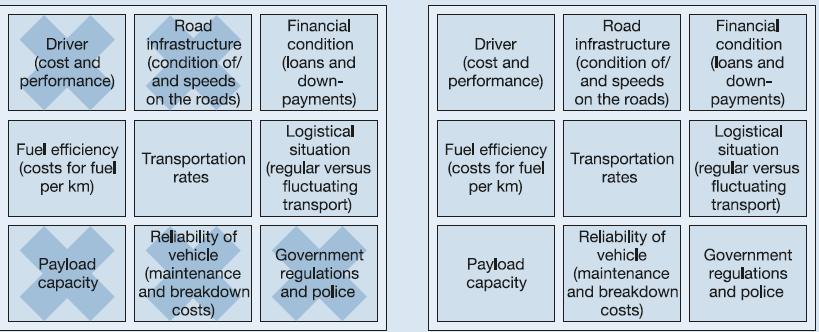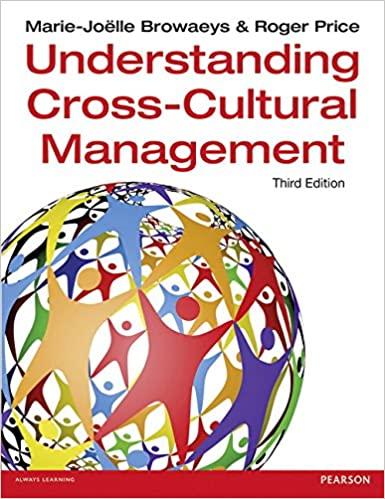Hauliers in India and Europe both face a competitive environment, and buying the best lorry for the
Question:
Hauliers in India and Europe both face a competitive environment, and buying the best lorry for the job is just half the battle. Both have to contend with a number of variables if they are to generate a healthy profit.
And the variables for the Indian haulier are very different from those faced by his European counterpart.
The main difference between these haulage sectors is the room to manoeuvre which these variables afford. In European countries, many variables are fixed: some are set by government regulations and others offer almost no choice. In terms of infrastructure, for example, when it comes to road conditions and speed limits, there are very few variables to be found. Equally importantly, every competitor can take full advantage of these facilities, so they offer no competitive advantage at all. In India, however, the road network shows many differences: some four-lane highways are available in the urban areas, while single lane potholed dirt roads are the only option for lorries in rural areas.
Figure 11.5 indicates the differences in management tools for the hauliers between both continents. The ‘crossed’ variables are fixed in the market. These clearly limit a haulier’s management decisions regarding investment in one area of variability to extract greater economies from another.
Figure 11.5

There are, for example, many variables attached to the lorry driver in India. A haulier could decide to employ either a trained and experienced truck driver (who knows the ins and outs of the lorry and how to use it profitably), or to hire an inexperienced driver (who has only worked as a co-driver and knows little about profitable lorry use). Either driver could be put to use in Europe and India, although the
European haulier would doubtless incur a loss if he used the inexperienced driver (assuming this driver had been able to get a driver’s licence in the first place). If the Indian haulier employs an experienced driver, he can make more profit on account of the driver’s reliability and efficient use of fuel. On the other hand, he knows this driver will ask for higher pay. If he uses an inexperienced driver, he can compensate for any loss of efficiency by overloading the driver’s lorry or by putting him on a very old lorry. In that way the haulier can still make a profit.
Both India and Western Europe have government-imposed restrictions on vehicle design and the use of lorries, although European regulations are generally a lot stricter. The few regulations that India does have can be manipulated easily because they are not being strictly enforced. Corruption among police officers is common and both hauliers and drivers frequently use this as a way of escaping regulatory restrictions.
Payload capacity is strictly fixed in Europe. Lorries are free to transport as long as they keep to the limits imposed by law. Lorry manufacturers and the trailer and body building industry have come up with lighter vehicles so that heavier payloads are possible, but these new lorries are available to the whole transport industry, so the payload is not a variable. The picture is very different in India. Here, government regulations and manufacturers’ maximum payloads do not ‘count’. The sky is the limit when it comes to load volumes: any load can be transported, as long as it stays on the vehicle.
The power – or otherwise – of government legislation has considerable influence on the thinking process of an Indian haulier. Unlike his counterpart in Europe, a haulier in India cannot claim financial compensation from a business supplier if the contract is discontinued without proper reason. Most transport contracts in India contain a clause allowing the supplier to discontinue the contract if he believes he can get a better deal elsewhere. Therefore, in contrast to his European counterpart, who is sure he has a deal when a contract is signed, the Indian haulier still has to face some uncertainty and insecurity, especially if he is saddled with high monthly financial instalments over and above his normal living costs. The Indian haulier, therefore, will want his vehicles on the road as much as possible to pay off these costs. No wonder, then, that drivers have to work long hours driving overloaded lorries.
Questions
1. Consider the following statement about variable ‘legislation and legal liability’:
Legislation can have a serious impact on market developments and the performance of current business models all over the world. The Indian government has announced its intention to bring legislation on transportation up to European levels. By doing this, it clearly demonstrates its appreciation of European developments in the industry. However, the implementation of such legislation does not necessarily result in a change of mentality or a change in the process. One needs to take into account the thinking process of an Indian lorry owner.
Using the information given in the case (and/or your experience), give your opinion on the above statement.
2. Consider Table 11.5 which compares marketing communication in the European and Indian lorry markets. Notice the differences between Europe and India concerning:
● Communication flow;
● Responsibility of the dealers, manufacturers, importers;
● Marketing strategy;
● Marketing activities.
Table 11.5

Step by Step Answer:

Understanding Cross Cultural Management
ISBN: 9781292015897
3rd Edition
Authors: Marie Joelle Browaeys, Roger Price





